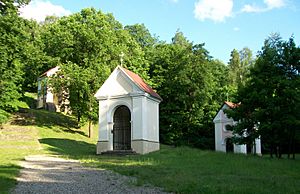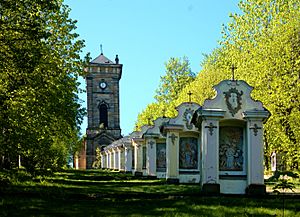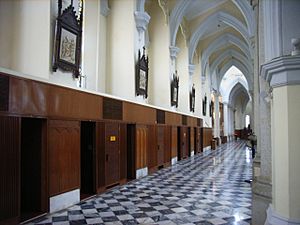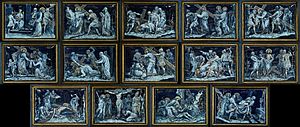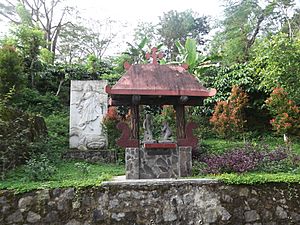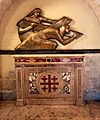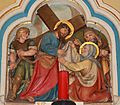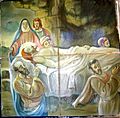Stations of the Cross facts for kids
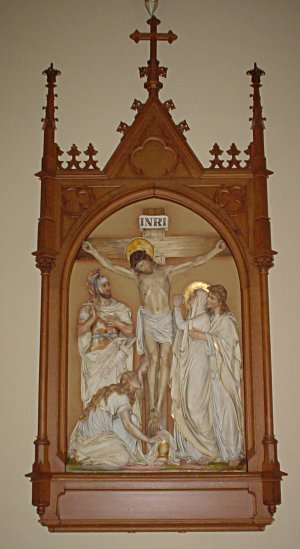
The Stations of the Cross (also called the Way of the Cross or Via Crucis) is a special set of images and prayers. These images show Jesus Christ on the day he was crucified. The Stations help Christians imagine walking the same path Jesus took to Mount Calvary in Jerusalem. It's like a spiritual journey to think about Jesus's suffering.
This devotion is very popular in many Christian churches, including Catholic, Lutheran, Anglican, and Methodist churches. Usually, there are 14 pictures or sculptures arranged along a path. People stop at each station to pray and think about what happened to Jesus. This is often done during Lent, especially on Good Friday. It helps people reflect on the pain Jesus went through.
The Stations can look very different. Some are small pictures or reliefs inside a church. Others are simple crosses with a number. Sometimes, people pray the Stations even without images, like when the Pope leads the prayers at the Colosseum in Rome.
Contents
History of the Stations
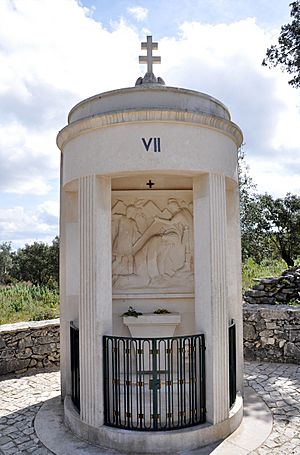
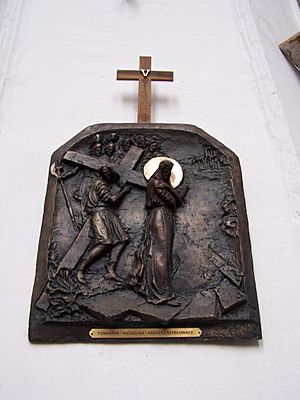
The idea for the Stations of the Cross came from people visiting Jerusalem. They wanted to experience the Via Dolorosa, the path Jesus walked. People had already copied holy places before, like the Santo Stefano complex in Bologna, Italy.
After Jerusalem was captured in 1187, members of the Franciscan religious group were allowed back into the Holy Land. Their founder, Saint Francis of Assisi, deeply respected Jesus's suffering. In 1217, St. Francis started the Custody of the Holy Land to protect Christian holy sites. The Pope officially recognized the Franciscans as guardians of these places in 1342.
In the 15th and 16th centuries, Franciscans began building outdoor shrines in Europe. These shrines copied the holy places in Jerusalem. The number of stations varied, but seven was common. They were often placed in small buildings leading to a church. Some were built on hills, becoming attractions themselves.
In 1686, the Pope allowed Franciscans to set up Stations inside their churches. Later, in 1731, this right was given to all churches. The number of stations was set at fourteen. By 1862, bishops could set up the Stations without a Franciscan priest.
The Fourteen Stations
Since the late 1500s, the standard Stations of the Cross have included 14 scenes. Here are the traditional 14 stations:
- Jesus is condemned to death
- Jesus takes up his Cross
- Jesus falls the first time
- Jesus meets his Mother
- Simon of Cyrene helps Jesus carry the Cross
- Veronica wipes the face of Jesus
- Jesus falls for the second time
- Jesus meets the women of Jerusalem
- Jesus falls for the third time
- Jesus is stripped of his clothes
- Jesus is nailed to the Cross
- Jesus dies on the Cross
- Jesus is taken down from the Cross
- Jesus is laid in the tomb
Sometimes, the Resurrection of Jesus is added as a 15th station, but this is not part of the traditional set. There is also a different version called the Via Lucis (Way of Light). This version focuses on Jesus's resurrection and ends with Pentecost.
Stations from the Bible
Only eight of the traditional 14 Stations are clearly found in the Bible. For example, the Bible does not mention Jesus falling three times or a woman named Veronica wiping his face. Also, the Bible says Joseph of Arimathea took Jesus down from the cross and buried him, not Mary.
Because of this, Pope John Paul II introduced a new set of Stations in 1991. These are called the Scriptural Way of the Cross because they follow the Bible more closely. He used these stations many times, especially at the Colosseum in Italy.
Here are the Scriptural Stations:
- Jesus prays in the Garden of Gethsemane
- Jesus is betrayed by Judas and arrested
- Jesus is condemned by the Sanhedrin
- Jesus is denied by Peter 3 times
- Jesus is judged by Pilate
- Jesus is scourged and crowned with thorns
- Jesus takes up his cross
- Jesus is helped by Simon of Cyrene to carry his cross
- Jesus meets the women of Jerusalem
- Jesus is crucified
- Jesus promises his kingdom to the repentant thief
- Jesus entrusts Mary and John to each other
- Jesus dies on the cross
- Jesus is laid in the tomb
In 2007, Pope Benedict XVI approved these Scriptural Stations for people to use.
How the Stations are Used Today
In the Catholic Church, people can pray the Stations by themselves, moving from one image to the next. Or, a priest can lead the prayers while everyone responds. The Stations must have at least fourteen wooden crosses. Pictures alone are not enough. These crosses must be blessed by someone with the right authority.
Pope John Paul II used to lead a public prayer of the Stations of the Cross every Good Friday at the Roman Colosseum. In his later years, he presided from a stage while others carried the cross. Each year, a different person is asked to write the prayers for the Stations.
Praying the Stations of the Cross is very common on Fridays during Lent, and especially on Good Friday. When groups pray together, they often sing songs and say prayers. A common song is the Stabat Mater.
Music and Literature
Many artists have created works inspired by the Stations of the Cross.
- Franz Liszt wrote a piece called Via Crucis for choir and instruments in 1879.
- In 1931, French organist Marcel Dupré created musical meditations for each station.
- David Bowie said his 1976 song "Station to Station" was "very much concerned with the stations of the cross."
- Polish composer Paweł Łukaszewski wrote Via Crucis in 2000.
- Italian composer Fabio Mengozzi released an electronic album called Via crucis in 2022.
When the Stations are prayed in Catholic churches, each station is often followed by a verse from the Stabat Mater. This poem was written in the 13th century by a Franciscan named Jacopone da Todi.
Images for kids
-
4th Station: Jesus meets his Mother
-
5th Station: Simon of Cyrene helps Jesus carry the Cross
-
6th Station: Veronica wipes the face of Jesus
-
11th Station: Jesus is nailed to the Cross
See also
 In Spanish: Vía crucis para niños
In Spanish: Vía crucis para niños
- Acts of Reparation to Jesus Christ
- Life of Jesus in the New Testament
- Seven Sorrows of Mary
- Sayings of Jesus on the cross
- Three Hours' Agony
- Via Lucis


